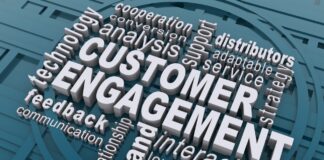The New Salesperson
Today’s information-rich buyers are increasingly unresponsive to yesterday’s sales techniques. This is making it more difficult than ever for salespeople to get through to prospects and decision makers on the phone, let alone to get them to attend physical business events or trade shows. Yet, without that person-to-person contact, they are unable to gauge prospects’ level of interest through traditional means such as body language and other non-verbal cues.
As so many salespeople watch their performance numbers ebb, they face a dilemma: either they adjust to the market by learning an entirely new set of skills (including how to work in concert with Marketing), or they continue to rely on those customers (an endangered species) who still seek out pre-millennial, old-fashioned pitchmen. Naturally, the wise money is on the former.
To put it mildly, the information-saturated, point-and-click world that is the Internet has forever changed customers and their buying behaviors. The buyer has taken control of the buying process away from the traditional sales rep. In the days of the Sales Cycle, it was the sales rep who was in a hurry to close the sale and move on. These days the buyer and the sales rep have swapped places. Today’s buyer is the one who is in a hurry to get to the satisfaction point of a purchase – once, that is, they have identified a need and researched their vendor options.
Sales training vendors have reacted to the new paradigm with a myriad of supposedly new training programs. To be fair, twentieth- and early-twenty-first-century sales training programs – thorough products of their time – worked well in the days of the Sales Cycle (provided they were implemented and managed appropriately). Now that the paradigm has shifted, there has been no small amount of scrambling on the part of sales trainers, who are doing their level best to hammer some old square pegs into some very new round holes. Yesterday’s techniques are being rebranded or adapted to supposedly suit the market’s new realities, but the changes seem mostly at the level of language.
In their essence, sales strategies (some of them now decades old) have remained unchanged. At the risk of potentially doing my sales training peers a disservice, it is my perception that the supposedly new and disruptive sales techniques are really little more than reinvented variants of yesteryears’ methods. A little more modishly dressed up, presented and packaged, but essentially the same. To me they look suspiciously like they are still channeling the basic elements of Neil Rackham’s SPIN method from 30 years ago. The difference being that we no longer expect our prospects to answer a multitude of situation-exploring questions before we attempt to sell them something. Prospects these days are far less patient and they expect modern reps who have done their homework.
The days of the charismatic but tactical salesperson are getting behind us, particularly in B2B sales. A winning personality still goes a long way, but today’s buyers aren’t looking for slick pitchmen. What they are looking for is a subject matter expert, somebody who knows exactly why buyers are solution-hunting in the first place, someone who has insight into their situation and solutions that are tailored to their most pressing issues. They don’t want to hear, “I’ll get back to you on that.” They want answers, and they want them now. Buyers are no longer looking for a sales rep; they are looking for an advisor. After they have conducted all their own research, they want to deal with someone who knows even more than they do about the problem they are trying to solve and the offering that they are most interested in. A poorly prepared or under-informed sales rep is likely to get very short shrift indeed. Don’t get me wrong, there are still buyers out there – particularly B2C buyers – who prefer to walk into a shop and buy from a sales rep on the shop floor. However, the trend is moving away from this long-familiar scenario.
During a guest lecture to the Executive MBA class of the Sydney Business School, I posed the following question to the attendees: How did you conduct your last major purchase? One of them described how he bought a big screen TV simply by walking into a popular retail store and asking the first rep sell them one. A small handful of other respondents cited similar or identical buying behaviors, all of them in a B2C context.
The vast majority of attendees, however, followed a very different path. To cite a single example, one lady in the front of the room said she had recently purchased a new family car. She described how she first went online to explore which cars were available that covered her needs within her price range. Then she went on to look at online vehicle test report sites and checked her impressions against the opinions of her friends, acquaintances and peers. Finally, she looked online at the personal perceptions and experiences of people who had previously purchased the same model that she was now considering.
By the time she was ready to speak to a sales rep she had already decided, not only what brand and model she wanted, but also what color it was to be, what options she required and what price she was prepared to pay. She told the class that she would have been quite prepared to even order the car online if that option had been available to her and that pretty much the only reason she and her husband visited a dealership was to take a test-drive in the car that they had decided to buy.
In summary, she had completed far more than 80% of her decision-making process before she contacted the car dealership. All that the salesperson could do was to take her order and to deliver the car. Can you see how the poor rep in the showroom had next to no control over the sale? All the power remained in the hands of the buyer. That is the power of the Buyer’s Journey.
We are now seeing signs that the above B2C mindset is starting to infiltrate the B2B sales world. Storytelling and sales presentations remain important pillars of the selling game, but they are increasingly trumped by situationally adept consultational skills that are complemented by extensive market insight and specialist solution expertise.
Modern information-rich pre-sales consultants are driving future sales. Even call centers are adjusting the way that their telemarketers or tele-prospectors work. Having traditionally been the light infantry of sales teams, they are changing their tactics, honing in on breaks in the line opened up, not so much by cold calling, but by highly targeted marketing campaigns. There is focus like never before on working the trigger points, i.e. those points at which the prospects’ buying journey and the vendors’ sales content or expert staff intersect.
At these intersections, the savviest of today’s vendors are erecting what I call ‘beacons of expertise’, which vendors are using to attract buyers during the online research phase of their journey. These take a variety of shapes: webinars, white papers, interviews, and sophisticated multi-channel social media engagements. While in the past these have largely been the exclusive domains of marketers, more and more salespeople are beginning to cross into these unfamiliar but bountiful waters. At the very least, salespeople are learning to turn their own familiarity with the same materials that their customers are encountering online to their advantage, especially when the prospect reaches out and initiates contact, perhaps with questions that relate to this content. If the salesperson is able to display much more than just a passing familiarity with the subject matter, they can start to assist the prospect through the final stages of the Buyer’s Journey and direct them away from competitor offerings towards their own.
However, not all salespeople are ready to adjust to the new world order. As sales managers who have been around since the days of Palo Alto Laboratories and the innovations that arrived in the 1970s can tell you, the reality is that many senior salespeople are little inclined to adjust their methods or mindset to fit new paradigms. This reluctance to metamorphose into the new sales environment is a substantial factor in the diminishing bottom line for many sales-based organizations.
Many of my executive clients tell me that they need to evolve from a product-centric organization to a customer-centric, solutions-oriented one, but that their own reps are unable or unwilling to make that transition.
In one of the largest technology vendor organizations that I have worked with, management had come to realize that future sales margins were going to come from selling solutions, not hardware. They tried, as gently as possible, to move their sales reps into pushing software to go with the hardware as a kind of ‘thin end of the wedge’, something that could slowly but surely transition their selling practices more towards solution-selling. The prevailing attitude of the died-in-the-wool hardware sales reps, though, was that, “Software is only 10% of the revenue, but it is 90% of the trouble. I’d rather sell another piece of hardware (colloquially referred to as a ‘box’) than any software.” The sad reality for this organization was that fewer than 20% of their reps were realistically capable of adapting to the new solution-selling paradigm. In no time at all, they were left without options. They were forced to transition out about 80% of their reps and sales managers and replace them with new blood. There’s no way to sugarcoat this: the financial and emotional costs were immense.
Drastic as the move may have seemed to the terminated staff or to uninformed outsiders, it was absolutely necessary for the future prosperity of the organization. For the organization in question, adapting to the new paradigm meant an almost complete overhaul of their sales department.
The alternative is worse. Old-school sales techniques being applied to new-school customers manifests itself in closure rates plummeting, too many sales leads remaining unattended, and too may ‘stuck deals’ in the sales pipeline that are not moving forward.
Here are three things the most successful of the new-school salespeople are doing consistently and are doing well:
Here are three things the most successful of the new-school salespeople are doing consistently and are doing well:
1) They are using social listening and in-depth research to catch buyers during their discovery and consideration phases
2) They are surprising and delighting potential buyers with data or insights that interrupt or divert their journey away from competitors
3) They are positioning themselves as subject matter experts and trusted advisors, rather than as sales reps
The first of these requires world-class communication between sales and marketing teams; the second demands significant dedication and flexibility on the part of salespeople, who need to broaden and deepen their scope if they are to adapt to today’s customers and their needs; the third requires the ongoing development of new skills and aptitudes. The demand for sales consultants who fit this mold is far outstripping supply, making it more difficult than ever for organizations to get out ahead of the rapidly swinging pendulum, which is swinging towards a vital new breed of sales reps who are as much subject matter experts and consultative solution salesperson as they are company representatives. These twenty-first-century salespeople are the avant garde in the ongoing revolution of sales practices.
Takeaway
The world of Sales has changed significantly over the last few years, and the boundaries to Marketing are beginning to blur.
Clearly, significant challenges abound and only a collaborative mindset is the way of a successful future.
Read part 1 – The Evolution of The Buyer’s Journey (Part 1)
Note from author – this is an excerpt from Peter Strohkorb’s book “The OneTEAM Method”.



































